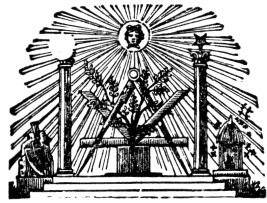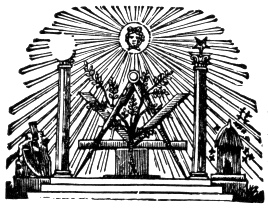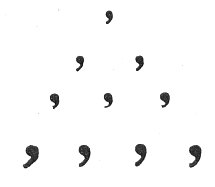Q. Were those columns adorned with any thing further?
A. They were, viz.: with two large globes or balls, one on each.
Q. What was the entire height of these pillars?
A. Forty cubits.
Q. Did they contain any thing?
A. They did, viz.: all the maps and charts of the celestial and terrestrial bodies.
Q. Why are they said to be so extensive?
A. To denote the universality of Masonry, and that a Mason’s y ought to be equally extensive.
Q. What was their composition?
A. Molten or cast brass.
Q. Who cast them?
p. 84
A. Our Grand Master, Hiram Abiff.
Q. Where were they cast?
A. On the banks of the river Jordan, in the clay ground between Succoth and Zaredatha, where King Solomon ordered these and all other holy vessels to be cast.
Q. Were they cast solid or hollow?
A. Hollow.
Q. What was their thickness?
A. Four inches, or a hand’s breadth.
Q. Why were they cast hollow?
A. The better to withstand inundations or conflagrations; they were said to contain all the archives of Masonry.
Q. What did you next come to?
A. A long, winding staircase, or flight of winding stairs, consisting of three, five, and seven steps.
Q. To what do the three steps allude?
A. The three principal supports in Masonry, namely: wisdom, strength, and beauty; they also allude to the three stages in human life: youth, manhood, and age; they further allude to the three degrees in Masonry: Entered Apprentice, Fellow Craft, and Master Mason.
Q. What do the five steps allude to?
A. The five orders in architecture, and the five human sensed.
Q. What are the five orders in architecture?
A. The Tuscan, Doric, Ionic, Corinthian, and Composite.
Q. What are the five human senses?
A. Hearing, seeing, feeling, smelling, and tasting; the first three of which have ever been deemed highly essential among Masons: hearing, to hear the word; seeing, to see the sign; and feeling, to feel the grip, whereby one Mason may know another in the dark as well as in the light.
Q. What do the seven steps allude to?
A. The seven Sabbatical years, seven years of famine, seven years of war, seven years in building the Temple, seven golden candlesticks, seven wonders of the world, seven planets; but, more especially, the seven liberal arts and sciences, which are grammar, rhetoric, logic, arithmetic, geometry, music, and astronomy. For these and many other reasons the number seven has ever been held in high estimation among Masons.
Q. What did you next come to?
A. The outer door of the Middle Chamber of King Solomon’s Temple, which I found partly open, but closely tyled by the Junior Warden in the south.
Q. How did you gain admission?
p. 85
A. By the pass, and token of the pass of a Fellow Craft.
Q. What was the name of the pass?
A. SHIBBOLETH.
Q. What does it denote?
A. Plenty.
Q. How is it represented?
A. By ears of corn hanging near a water-ford.
Q. Why originated this word as a pass?
A. In consequence of a quarrel which had long existed between Jephthah, Judge of Israel, and the Ephraimites, &c., &c. (for the balance, see page 75).
Q. What did you next discover?
A. The inner door of the Middle Chamber of King Solomon’s Temple.
Q. How did you gain admission?
A. By the grip and word of a Fellow Craft–Jachin.
Q. How did the Senior Warden dispose of you?
A. He ordered me to be conducted to the Worshipful Master in the east, who informed me that I had arrived at a place rep-resenting the Middle Chamber of King Solomon’s Temple, where I would be received and recorded as such; which record was then made by the Secretary (by the orders of the Worshipful Master), and I was presented with the wages of a Fellow Craft, and also the jewels of a Fellow Craft.
Q. What are the wages of a Fellow Craft?
A. The corn of nourishment, the wine of refreshment, and the oil of joy.
Q. What do they denote?
A. Peace, harmony, and strength.

Moe is the founder of GnosticWarrior.com. He is a father, husband, author, martial arts black belt, and an expert in Gnosticism, the occult, and esotericism.




